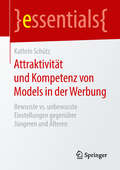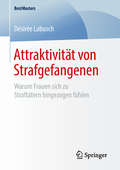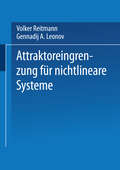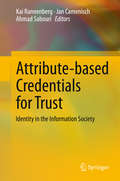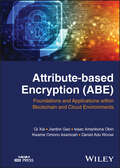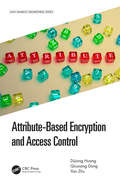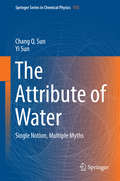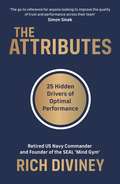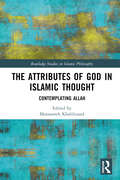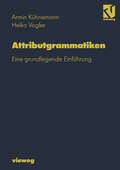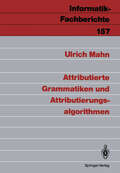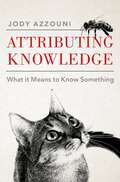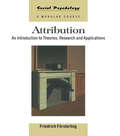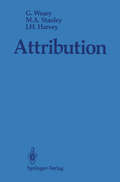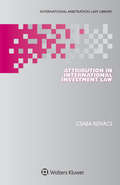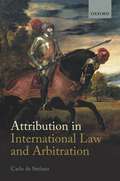- Table View
- List View
Attraktiver Mathematikunterricht: Motivierende Beispiele aus der Praxis
by Jürgen MaaßDieses Sachbuch zeigt Wege zu einem attraktiveren Mathematikunterricht in Beispielen auf, die als Abschlussarbeiten seiner ehemaliger Studenten (und Coautoren) praxiserprobt sind. Das Buch lädt zur Reflexion der eigenen Erfahrungen mit Mathematikunterricht und einer Diskussion darüber ein. Farbige Kästen fordern zur aktiven Teilnahme oder Weiterführung der Projekte auf.
Attraktivität und Kompetenz von Models in der Werbung: Bewusste vs. unbewusste Einstellungen gegenüber Jüngeren und Älteren (essentials)
by Kathrin SchützDieses essential zeigt, wie sich neben jüngeren auch ältere Models gezielt in der Werbung einsetzen lassen und welche Altersgruppe für welche Produkte und Dienstleistungen geeignet ist. Passen jüngere Models generell besser zu Produkten für jüngere Konsumenten und gilt dies im Umkehrschluss auch für ältere Models? Möchten Jüngere und Ältere von Personen ihres Alters angesprochen werden oder kommt es auf die Passung zwischen Model und Produkt an? Die Autorin gibt einen Überblick über wissenschaftliche Erkenntnisse und untersucht aus Sicht der Jüngeren als auch der Älteren bewusste und unbewusste Einstellungen im Zusammenhang mit Altersstereotypen.
Attraktivität von Cross-Selling-Angeboten aus Kundensicht: Konstruktentwicklung und Überprüfung im Wirkungsmodell
by Philip MaitzenPhilip Maitzen untersucht in dieser Arbeit die Dimensionen der Attraktivitätsbewertung von Cross-Selling-Angeboten durch den Kunden. Er entwickelt dazu das Konstrukt der Attraktivität, identifiziert seine bildenden Elemente, und untersucht sie empirisch. Auf Basis dieser Ergebnisse erstellt er ein Konzept zur Messung und Steuerung der Attraktivität von Cross-Selling-Angeboten für die Praxis.Cross-Selling stellt eine Möglichkeit dar, zusätzliche Umsätze zu generieren und den Kunden enger an das eigene Unternehmen zu binden. Dennoch ist eine Vielzahl von Cross-Selling-Initiativen nicht vom gewünschten Erfolg gekrönt. In letzter Instanz ist der Cross-Selling-Erfolg vom Kunden abhängig, nämlich in der Form, ob der Kunde das Angebot in Anspruch nimmt oder nicht. Insofern kommt der Attraktivitätsbewertung eine besondere Bedeutung zu.
Attraktivität von Strafgefangenen: Warum Frauen sich zu Straftätern hingezogen fühlen (BestMasters)
by Désirée LabuschDésirée Labusch bietet eine vollständige Zusammenfassung der bisher bestehenden Untersuchungen über Frauen, die einen Partner wählen, der zum Zeitpunkt des Kennenlernens inhaftiert ist. Unter besonderer Berücksichtigung ihrer evolutionären Adaptivität und ihres austauschtheoretischen Nutzens werden die 13 wichtigsten, vor allem klinischen, psychoanalytischen, sozialisations- und persönlichkeitspsychologischen Erklärungsansätze sowohl inhaltlich als auch empirisch differenziert analysiert. Die Ergebnisse zeigen, dass es zwei verschiedene Typen von Strafgefangenen gibt, die von Frauen als attraktiv empfunden werden. Diese Frauen unterscheiden sich in ihren Persönlichkeitseigenschaften und Sozialisationserfahrungen.
Attraverso il microscopio: Neuroscienze e basi del ragionamento clinico (I blu)
by Davide SchifferIl libro prende le mosse dai pensieri di un giovane che alla maturità liceale si trova affascinato dalla cultura dei classici greco-latini, dai rudimenti filosofici e dall’impatto con le scienze fisiche e naturali. Il latino e i suoi naturalisti hanno suscitato un fervore verso la Botanica Sistematica che lo riporta a Linneo e quindi alla conoscenza del mondo naturale, all’esperienza della denominazione dell’esistente come conoscenza e quindi agli universali di Guglielmo d’Occam. La scelta della facoltà di Medicina fungerà da mediazione fra la filosofia, vista come via alla verità, e la biologia con il grande mistero dell’uomo nella sua dualità di mente/corpo. L’incontro con il microscopio aprirà la strada all’approfondimento della biologia, ma anche alla ricerca dei significati e delle interpretazioni del mondo. I meccanismi della percezione, visiva in particolare, nelle articolazioni della Gestaltpsychologie, e i suoi rapporti con il mondo interiore, sia quello della memoria esplicita che della memoria implicita, sono affrontati nell’esplorazione del mondo attraverso il microscopico e nella ricerca di una obiettività scientifica. Locke e Kant, Popper e Heidegger fanno da contraltare a Ramon y Cajal, Golgi, Kandel, Heisenberg, mentre la semiotica illumina e confonde sull’importanza del linguaggio per la conoscenza. Il segno e il suo riconoscimento si trasferiscono nella scienza attraverso l’inter-soggettività e il linguaggio appare come l’unico modo di penetrare l’esistente. Il libro si dilunga sull’origine di certe denominazioni in patologia tratte dalla vita quotidiana, sull’antropomorfismo spesso applicato agli oggetti del campo microscopico, sempre illustrati su base fenomenologica e psicologica.
Attribute-based Credentials for Trust: Identity in the Information Society
by Kai Rannenberg Jan Camenisch Ahmad SabouriThe need for information privacy and security continues to grow and gets increasingly recognized. In this regard, Privacy-preserving Attribute-based Credentials (Privacy-ABCs) are elegant techniques to provide secure yet privacy-respecting access control. This book addresses the federation and interchangeability of Privacy-ABC technologies. It defines a common, unified architecture for Privacy-ABC systems that allows their respective features to be compared and combined Further, this book presents open reference implementations of selected Privacy-ABC systems and explains how to deploy them in actual production pilots, allowing provably accredited members of restricted communities to provide anonymous feedback on their community or its members. To date, credentials such as digitally signed pieces of personal information or other information used to authenticate or identify a user have not been designed to respect the users’ privacy. They inevitably reveal the identity of the holder even though the application at hand often needs much less information, e.g. only the confirmation that the holder is a teenager or is eligible for social benefits. In contrast, Privacy-ABCs allow their holders to reveal only their minimal information required by the applications, without giving away their full identity information. Privacy-ABCs thus facilitate the implementation of a trustworthy and at the same time privacy-respecting digital society.The ABC4Trust project as a multidisciplinary and European project, gives a technological response to questions linked to data protection.Viviane Reding(Former Vice-president of the European Commission, Member of European Parliament)
Attribute-based Encryption (ABE): Foundations and Applications within Blockchain and Cloud Environments
by Qi Xia Jianbin Gao Isaac Amankona Obiri Kwame Omono Asamoah Daniel Adu WoraeAttribute-based Encryption (ABE) Enables readers to understand applications of attribute-based encryption schemes in cloud computing with the support of blockchain technology With a focus on blockchain technology, Attribute-based Encryption (ABE) provides insight into the application of attribute-based encryption (ABE) schemes, discussing types of blockchains, fundamentals of blockchain, and how blockchains are constructed. Comprised of 16 chapters, the text provides an overview of the components that go into creating a dual ABE system of encryption proofs within the following: composite bilinear groups, dual pairing vector space framework, matrix pairing framework, framework for matrix pairing, and the application of cryptographic scheme on blockchain. The team of authors discuss the basic construction components of ABE and share the security models, including the selective and semi- adaptive security models, applying these to either prime order or composite order groups. The book also discusses the tools used for converting a composite order ABE scheme to prime order and an adaptive secure ABE scheme based on prime order. In Attribute-based Encryption (ABE), readers can expect to find information on: Mathematical background of ABE, covering group and cyclic group, elliptic curves, curve selection, supersingular curves, ordinary curves, and weil and tate pairing Basic construction components of ABE, covering access structure, monotone Boolean formula, linear secret-sharing scheme, and ordered binary decision diagram Tools for converting composite order ABE schemes to prime order, covering security assumptions and conversion based on vectors for preliminaries, scheme construction, and security proof technique Foundations of blockchain technology, covering blocks, miners, hash functions, and public key cryptography Attribute-based Encryption (ABE) is an essential resource for professionals working in the field of design and cybersecurity who wish to understand how to use blockchain and the ABE scheme to provide fine-grained access control in outsourced data on third-party cloud servers.
Attribute-based Encryption (ABE): Foundations and Applications within Blockchain and Cloud Environments
by Qi Xia Jianbin Gao Isaac Amankona Obiri Kwame Omono Asamoah Daniel Adu WoraeAttribute-based Encryption (ABE) Enables readers to understand applications of attribute-based encryption schemes in cloud computing with the support of blockchain technology With a focus on blockchain technology, Attribute-based Encryption (ABE) provides insight into the application of attribute-based encryption (ABE) schemes, discussing types of blockchains, fundamentals of blockchain, and how blockchains are constructed. Comprised of 16 chapters, the text provides an overview of the components that go into creating a dual ABE system of encryption proofs within the following: composite bilinear groups, dual pairing vector space framework, matrix pairing framework, framework for matrix pairing, and the application of cryptographic scheme on blockchain. The team of authors discuss the basic construction components of ABE and share the security models, including the selective and semi- adaptive security models, applying these to either prime order or composite order groups. The book also discusses the tools used for converting a composite order ABE scheme to prime order and an adaptive secure ABE scheme based on prime order. In Attribute-based Encryption (ABE), readers can expect to find information on: Mathematical background of ABE, covering group and cyclic group, elliptic curves, curve selection, supersingular curves, ordinary curves, and weil and tate pairing Basic construction components of ABE, covering access structure, monotone Boolean formula, linear secret-sharing scheme, and ordered binary decision diagram Tools for converting composite order ABE schemes to prime order, covering security assumptions and conversion based on vectors for preliminaries, scheme construction, and security proof technique Foundations of blockchain technology, covering blocks, miners, hash functions, and public key cryptography Attribute-based Encryption (ABE) is an essential resource for professionals working in the field of design and cybersecurity who wish to understand how to use blockchain and the ABE scheme to provide fine-grained access control in outsourced data on third-party cloud servers.
Attribute-Based Encryption and Access Control (Data-Enabled Engineering)
by Dijiang Huang Qiuxiang Dong Yan ZhuThis book covers a broader scope of Attribute-Based Encryption (ABE), from the background knowledge, to specific constructions, theoretic proofs, and applications. The goal is to provide in-depth knowledge usable for college students and researchers who want to have a comprehensive understanding of ABE schemes and novel ABE-enabled research and applications. The specific focus is to present the development of using new ABE features such as group-based access, ID-based revocation, and attributes management functions such as delegation, federation, and interoperability. These new capabilities can build a new ABE-based Attribute-Based Access Control (ABAC) solution that can incorporate data access policies and control into ciphertext. This book is also ideal for IT companies to provide them with the most recent technologies and research on how to implement data access control models for mobile and data-centric applications, where data access control does not need to rely on a fixed access control infrastructure. It’s also of interested to those working in security, to enable them to have the most recent developments in data access control such as ICN and Blockchain technologies. Features Covers cryptographic background knowledge for ABE and ABAC Features various ABE constructions to achieve integrated access control capabilities Offers a comprehensive coverage of ABE-based ABAC Provides ABE applications with real-world examples Advances the ABE research to support new mobile and data-centric applications
Attribute-Based Encryption and Access Control (Data-Enabled Engineering)
by Dijiang Huang Qiuxiang Dong Yan ZhuThis book covers a broader scope of Attribute-Based Encryption (ABE), from the background knowledge, to specific constructions, theoretic proofs, and applications. The goal is to provide in-depth knowledge usable for college students and researchers who want to have a comprehensive understanding of ABE schemes and novel ABE-enabled research and applications. The specific focus is to present the development of using new ABE features such as group-based access, ID-based revocation, and attributes management functions such as delegation, federation, and interoperability. These new capabilities can build a new ABE-based Attribute-Based Access Control (ABAC) solution that can incorporate data access policies and control into ciphertext. This book is also ideal for IT companies to provide them with the most recent technologies and research on how to implement data access control models for mobile and data-centric applications, where data access control does not need to rely on a fixed access control infrastructure. It’s also of interested to those working in security, to enable them to have the most recent developments in data access control such as ICN and Blockchain technologies. Features Covers cryptographic background knowledge for ABE and ABAC Features various ABE constructions to achieve integrated access control capabilities Offers a comprehensive coverage of ABE-based ABAC Provides ABE applications with real-world examples Advances the ABE research to support new mobile and data-centric applications
The Attribute of Water: Single Notion, Multiple Myths (Springer Series in Chemical Physics #113)
by Chang Q Sun Yi SunThis book features the latest advances and future trends in water science and technology. It also discusses the scientific popularization and quantitative resolution of a variety of mysterious properties of water and ice from the perspective of hydrogen-bond cooperativity in response to stimuli such as chemical contamination, electrification, magnetification, mechanical compression, molecular undercoordination, and thermal excitation. Anomalies include the floating of ice, the Hofmeister effect in solutions, regelation of ice, slipperiness of ice, water’s tough skin, the Mpemba paradox, and the floating bridge. It also addresses the superfluidity of microchannels, hydrogen bond potentials, nanodroplet and bubble thermodynamics, quasisolidity and supersolidity, controlling superhydrophobicity–superhydrophilicity transition, and high-pressure ice formation. The target audience for this book includes students, senior scholars, engineers and practitioners in the area of physical chemistry, biology, as well as aqueous and colloid solutions.
The Attributes: 25 Hidden Drivers of Optimal Performance
by Rich Diviney'So much of what I know about trust I learned from Rich Diviney'- Simon Sinek'Incredible... explains why some people thrive - even when things get hard' - Charles Duhigg'If you care about getting better, you need to buy this book' Daniel CoyleLearn the secret to being your bestDuring his twenty years as a Navy officer and SEAL, Rich Diviney was intimately involved in specialized SEAL selection, whittling hundreds of extraordinary candidates down to a handful of elite performers. But Diviney was often surprised by who succeeded. Those with the right skills sometimes failed, while others he had initially dismissed became top performers. Why weren't the most skillful candidates the ones who would succeed best in some of the world's toughest military assignments? Through years of observation, Diviney cracked the code: beneath obvious skills are a successful recruit's core attributes, the innate traits for a person's performance as an individual and in a team. This book defines these key attributes - including cunning, adaptability, even narcissism - so you can identify and understand your own and those of people around you, helping you perform optimally in all areas of your life.
The Attributes of God in Islamic Thought: Contemplating Allah (Routledge Studies in Islamic Philosophy)
by Mansooreh KhalilizandThe debate over Allah’s attribute—the “nature” and the inner articulation of Allah—is one of the focal debates in the intellectual history of Islam. This edited collection aims to highlight and examine some aspects of this debate in their original context, based on the relevant primary literature.By showing that even an apparently self-evident concept such as Allah, which lies at the heart of every reading of Islam, is highly ambiguous and polysemous, the chapters also emphasise the plurality that has always existed in Islamic thought. Through highlighting the philosophical and theological reflections on the concept of Allah, the results of this study challenge the juristic reading of Islam, in which Allah’s function consists mainly in providing a detailed plan for the human life and also rewarding or punishing the ones who deviates from it. The book also attempts to demonstrate the relevance and the actuality of the tradition and to stress its contemporaneity.This volume makes a significant part of the intellectual tradition of Islam accessible for students and scholars of Islamic theology, Islamic philosophy, Islamic studies and the like, as well as providing a secondary source for teaching on the debate in question.
The Attributes of God in Islamic Thought: Contemplating Allah (Routledge Studies in Islamic Philosophy)
The debate over Allah’s attribute—the “nature” and the inner articulation of Allah—is one of the focal debates in the intellectual history of Islam. This edited collection aims to highlight and examine some aspects of this debate in their original context, based on the relevant primary literature.By showing that even an apparently self-evident concept such as Allah, which lies at the heart of every reading of Islam, is highly ambiguous and polysemous, the chapters also emphasise the plurality that has always existed in Islamic thought. Through highlighting the philosophical and theological reflections on the concept of Allah, the results of this study challenge the juristic reading of Islam, in which Allah’s function consists mainly in providing a detailed plan for the human life and also rewarding or punishing the ones who deviates from it. The book also attempts to demonstrate the relevance and the actuality of the tradition and to stress its contemporaneity.This volume makes a significant part of the intellectual tradition of Islam accessible for students and scholars of Islamic theology, Islamic philosophy, Islamic studies and the like, as well as providing a secondary source for teaching on the debate in question.
Attributgrammatiken: Eine grundlegende Einführung
by Armin Kühnemann Heiko VoglerDas Buch bietet eine grundlegende Einführung in die Technik der Attributgrammatiken. Im Compilerbau haben sich Attributgrammatiken als nützliches Werkzeug zur Spezifikation kontextsensitiver Nebenbedingungen und der Übersetzung von Programmiersprachen erwiesen. Im Mittelpunkt des Buches stehen die Algorithmen zur Attributauswertung und die Beziehungen zu anderen Programmierparadigmen. Das Buch zeichnet sich durch seine formale Darstellung aus und kann sehr gut als Grundlage für Lehrveranstaltungen in Informatik, Mathematik und ingenieurwissenschaftlichen Fächern benutzt werden. Durch die vielen begleitenden Beispiele und Übungsaufgaben ist es auch zum Selbststudium geeignet. Nicht nur Dozenten und Studenten, sondern auch der erfahrene Compilerdesigner und der Entwickler von Programmierumgebungen werden intensiven Nutzen aus diesem Buch ziehen können.
Attributierte Grammatiken und Attributierungsalgorithmen (Informatik-Fachberichte #157)
by Ulrich MahnDiese Monographie gibt einen systematischen Überblick über Attributierte Grammatiken als ein Mittel zur Darstellung und Analyse von Kontextabhängigkeiten in Compilern unter Betonung der für Compiler-erzeugende Systeme erforderlichen Algorithmen. Attributierte Grammatiken sind ein inzwischen weltweit anerkanntes Mittel zur Beschreibung der statischen Semantik von Programmiersprachen. Mit der verstärkten Verbreitung von Compiler-Generatoren wird es auch für den Praktiker interessant, für spezielle Zwecke geeignete Sprachen zu entwickeln und zu implementieren. Diese ausführliche vergleichende Darstellung der verfügbaren Ergebnisse und Methoden weist auch dem Nichtspezialisten den Weg, einen für seine Sprache geeigneten Algorithmus zu finden. Betont werden vor der Systematik der theoretischen Erkenntnisse vor allem die in Compiler-Erzeugenden Systemen wie GAG oder HLP78 bewährten Algorithmen. Für den im Compilerbau Tätigen sind sicherlich die einheitliche Zusammenfassung der großen Vielzahl bekannter Ergebnisse über Attributierte Grammatiken und die sehr umfangreiche Bibliographie von Interesse.
Attributing Knowledge: What It Means to Know Something
by Jody AzzouniIn Attributing Knowledge, Jody Azzouni challenges philosophical conventions about what it means to know something. He argues that the restrictive conditions philosophers place on knowers only hold in special cases; knowledge can be attributed to babies, sophisticated animals (great apes, orcas), unsophisticated animals (bees), and machinery (drones, driverless cars). Azzouni also gives a fresh defense of fallibilism. Relying on lexical semantics and ordinary usage, he shows that there are no knowledge norms for assertion or action. He examines everyday cases of knowledge challenge and attribution to show many recent and popular epistemological positions are wrong. By providing a long-sought intelligible characterization of knowledge attribution, Azzouni explains why the concept has puzzled philosophers so long, and he solves longstanding and recent puzzles that have perplexed epistemologists--including the dogmatism paradox, Gettier puzzles, and the surprise-exam paradox. "This is a terrific book, full of surprises. For instance, Chapter 9 is full of points that are original, insightful, and useful in helping to resolve stale debates. I especially liked the points that we don't ordinarily describe someone as losing knowledge by gaining defeating evidence, that "knows" is vague and tri-scoped, that vagueness needn't be explained by appeal to precise metasemantic machinery, and that Williamson's anti-luminosity argument founders on the fact that knowledge doesn't require confidence. Bravo!" --Ram Neta, University of North Carolina, Chapel Hill Praise for Jody Azzouni's Ontology without Borders: "Azzouni offers a very strong drink, proposing that we do without central elements of what almost anyone would call logic or ontology. His arguments are serious and wide-ranging. If he's right, the reader will have learned something very important. If he's wrong, then the reader who figures out how he went wrong will also have learned something very important. Not every book has this feature." --Michael Gorman, The Catholic University of America
Attributing Knowledge: What It Means to Know Something
by Jody AzzouniIn Attributing Knowledge, Jody Azzouni challenges philosophical conventions about what it means to know something. He argues that the restrictive conditions philosophers place on knowers only hold in special cases; knowledge can be attributed to babies, sophisticated animals (great apes, orcas), unsophisticated animals (bees), and machinery (drones, driverless cars). Azzouni also gives a fresh defense of fallibilism. Relying on lexical semantics and ordinary usage, he shows that there are no knowledge norms for assertion or action. He examines everyday cases of knowledge challenge and attribution to show many recent and popular epistemological positions are wrong. By providing a long-sought intelligible characterization of knowledge attribution, Azzouni explains why the concept has puzzled philosophers so long, and he solves longstanding and recent puzzles that have perplexed epistemologists--including the dogmatism paradox, Gettier puzzles, and the surprise-exam paradox. "This is a terrific book, full of surprises. For instance, Chapter 9 is full of points that are original, insightful, and useful in helping to resolve stale debates. I especially liked the points that we don't ordinarily describe someone as losing knowledge by gaining defeating evidence, that "knows" is vague and tri-scoped, that vagueness needn't be explained by appeal to precise metasemantic machinery, and that Williamson's anti-luminosity argument founders on the fact that knowledge doesn't require confidence. Bravo!" --Ram Neta, University of North Carolina, Chapel Hill Praise for Jody Azzouni's Ontology without Borders: "Azzouni offers a very strong drink, proposing that we do without central elements of what almost anyone would call logic or ontology. His arguments are serious and wide-ranging. If he's right, the reader will have learned something very important. If he's wrong, then the reader who figures out how he went wrong will also have learned something very important. Not every book has this feature." --Michael Gorman, The Catholic University of America
Attribution: An Introduction to Theories, Research and Applications (Social Psychology: A Modular Course)
by Friedrich FörsterlingAttribution concerns the scientific study of naive theories and common-sense explanations. This text provides a thorough and up-to-date introduction to the field, combining comprehensive coverage of the fundamental theoretical ideas and most significant research with an overview of more recent developments. The author begins with a broad overview of the central questions and basic assumptions of attribution research. This is followed by discussion of the ways in which causal explanations determine reactions to success or failure and how our causal explanations of other people's actions shape our behaviour toward them. The manner in which attributions may shape communication, and how people often quite indirectly communicate their beliefs about causality, is also explained. Finally, the issue of changing causal connections in training and therapy is addressed. With end of chapter summaries, further reading and exercises to illustrate key attribution phenomena, Attribution will be essential reading for students of social psychology and associated areas such as personality, educational, organisational and clinical psychology.
Attribution: An Introduction to Theories, Research and Applications (Social Psychology: A Modular Course)
by Friedrich FörsterlingAttribution concerns the scientific study of naive theories and common-sense explanations. This text provides a thorough and up-to-date introduction to the field, combining comprehensive coverage of the fundamental theoretical ideas and most significant research with an overview of more recent developments. The author begins with a broad overview of the central questions and basic assumptions of attribution research. This is followed by discussion of the ways in which causal explanations determine reactions to success or failure and how our causal explanations of other people's actions shape our behaviour toward them. The manner in which attributions may shape communication, and how people often quite indirectly communicate their beliefs about causality, is also explained. Finally, the issue of changing causal connections in training and therapy is addressed. With end of chapter summaries, further reading and exercises to illustrate key attribution phenomena, Attribution will be essential reading for students of social psychology and associated areas such as personality, educational, organisational and clinical psychology.
Attribution
by Gifford Weary Melinda A. Stanley John H. HarveyThis book initially was conceived in 1986 by Weary and Harvey as a revi sion and update of their 1981 Perspectives on Attributional Processes (pub lished by Wm. C. Brown," Dubuque, Iowa). However: toe extensive nature of recent work on attributional processes and the opportunity to collabo rate with Melinda Stanley as a coauthor led to a plan to develop a more comprehensive work than the 1981 book. It definitely is an amalgam of our interests in social and clinical psychology. It represents our commitment to basic theoretical and empirical inquiry blended with the applications of ideas and methods to understanding attribution in more naturalistic set tings, and as it unfolds in the lives of different kinds of people coping with diverse problems of living. The book represents a commitment also to the breadth of approach to attribution questions epitomized by Fritz Heider's uniquely creative mind and work in pioneering the area. To us, the attribu tional approach is not a sacrosanct school of thought on the human condi tion. It is, rather, a body of ideas and findings that we find to be highly useful in our work as social (JH and GW) and clinical (GW and MS) psychology scholars. It is an inviting approach that, as we shall describe in the book, brings together ideas and work from different fields in psychology-all concerned with the pervasive and inestimab1e importance of interpretive activity in human experience and behavior.
Attribution in International Investment Law (International Arbitration Law Library Series Set)
by Csaba KovácsThe term ‘attribution’ refers to the means by which it is ascertained whether the State is involved in a dispute governed by international law. The notion of attribution is primarily used to determine if the State is responsible for the wrongful conduct of persons or entities with links to the State. In the context of international investment law, the exponentially growing arbitration jurisprudence arising from international investment agreements (IIAs), especially bilateral investment treaties (BITs), reflects the extent and risk of attribution determined in investment relationships that often involve State enterprises. This book, the first in-depth study of the uses of attribution in international investment law, provides a deeply informed analysis of the treatment of attribution in applicable legal instruments and investment arbitration jurisprudence worldwide. The analysis responds to such questions as the following: - When is a conduct attributable to the State for the purposes of its responsibility under international investment law? - What legal instruments govern the question of attribution under international investment law? - In what circumstances is the State the proper party to a contract entered into by a State-owned enterprise with an investor protected by an investment treaty? - How can State policymakers minimise their international law responsibility within the existing framework of attribution in international investment law? - How can investors maximise their protection within the existing framework of attribution in international investment law? Also covered are the procedural treatment of attribution by investment tribunals, explication of such broad-brush wordings as ‘elements of governmental authority’ and ‘under the direction or control’, and the impact of the rise of State-owned enterprises as investors. Ongoing and future trends in the jurisprudence are also taken into account. A one-stop reference on the question of attribution in international investment law, the analysis extracts identifiable commonalities among instruments and rulings, turning them into useful practice tools. This book will prove invaluable for practitioners advising States or investors in investment disputes. More generally, this book will be welcomed by arbitrators, in-house counsel for companies doing transnational business and international arbitration centres, as well as by academics in international arbitration.
Attribution in International Law and Arbitration
by Carlo de StefanoAttribution in International Law and Arbitration clarifies and critically discusses the international rules of attribution of conduct, particularly regarding their application to states under international investment law. It examines the key question of how and to what extent breaches of State obligations, particularly in respect of States' commitments to foreign investors under international investment agreements (IIAs) and bilateral investment treaties (BITs), can be attributed. Of special interest within this context is the responsibility of States when the alleged breach has been committed by separate legal entities, rather than the state itself. Under domestic law, entities such as state-owned enterprises (SOEs) are considered legally distinct, however the State may still be considered responsible for their actions under international law. The book addresses the relevant issues systematically, beginning with direct reference to the Draft Articles on Responsibility of States for Internationally Wrongful Acts (ARSIWA) on attribution, finalized by the International law Commission (ILC) in 2001. It then elaborates on the specifics of international investment law, based on a detailed examination of practice and case law, whilst giving due consideration to the academic debate. The result is a full, innovative take on one of the most difficult questions in investment arbitration.
Attribution in International Law and Arbitration
by Carlo de StefanoAttribution in International Law and Arbitration clarifies and critically discusses the international rules of attribution of conduct, particularly regarding their application to states under international investment law. It examines the key question of how and to what extent breaches of State obligations, particularly in respect of States' commitments to foreign investors under international investment agreements (IIAs) and bilateral investment treaties (BITs), can be attributed. Of special interest within this context is the responsibility of States when the alleged breach has been committed by separate legal entities, rather than the state itself. Under domestic law, entities such as state-owned enterprises (SOEs) are considered legally distinct, however the State may still be considered responsible for their actions under international law. The book addresses the relevant issues systematically, beginning with direct reference to the Draft Articles on Responsibility of States for Internationally Wrongful Acts (ARSIWA) on attribution, finalized by the International law Commission (ILC) in 2001. It then elaborates on the specifics of international investment law, based on a detailed examination of practice and case law, whilst giving due consideration to the academic debate. The result is a full, innovative take on one of the most difficult questions in investment arbitration.

